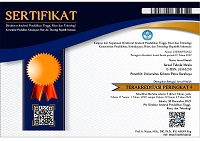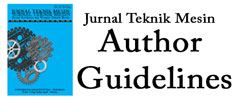Pemodelan, Pengujian, dan Analisis Getaran Torsional dari Perangkat Uji Sistem Poros-Rotor
Keywords:
Modeling, tersional vibration, rotor shaft systemAbstract
Vibrations of rotating machinary can be classified as translational and rotational. The vibrations occurred in rotational direction are commonly classified as torsional vibration. Torsional vibration can cause fatigue damage of shaft, coupling, or gear. In this paper, a method for measuring torsional vibration is proposed. This method uses two incremental encoders and an algorithm to process the data. To show its effectiveness, the method was implemented to measure torsional vibration of a rotor shaft system. The paper also shows the torsional vibration characteristics of of the system. To predict the torsional natural frequencies of the system, a finite elemen model was developed using Ansys Workbench 11 and the results was validite using a torsional FRF test. The measurement was performed a range of rotational speed to enable a spectral map can be constructed. There were two types of flexible couplings used in this work, a hose coupling and a rubber jaw coupling. The results of the experiment show that the proposed method can be implemented very well to measure the torsional vibration of the rotor shaft-system. In addition, the torsional vibration of the rotor shaft system has a similar characteristics to that of translational vibration, in which vibration signal is dominated by component with frequency of 1xRPM. The results also show that the level of torsional vibration depends on the type of flexible coupling being used. Due to low torsional stiffness, hose coupling produce low natural frequencies than those of jaw coupling. As a consequence, hose coupling are liable to higher vibration than jaw coupling. Abstract in Bahasa Indonesia: Getaran yang terjadi pada mesin dapat berupa getaran translasi maupun rotasi. Getaran yang terjadi dalam arah rotasi sering disebut sebagai getaran torsional. Getaran torsional dapat mengakibatkan terjadinya gagal lelah pada poros, kopling, maupun roda gigi. Dalam makalah ini, diusulkan sebuah metode pengukuran getaran torsional dengan dua buah enkoder. Untuk menunjukkan kemampuannya, metode ini diterapkan untuk mengukur getaran torsional pada sebuah perangkat uji sistem poros rotor. Selain itu juga akan ditunjukkan perilaku getaran torsional yang terjadi. Untuk mengetahui frekuensi pribadi torsional obyek uji, dilakukan pemodelan metoda elemen hingga dengan perangkat lunak Ansys Workbench 11, sedangkan untuk memvalidasinya dilakukan pengujian FRF (Fungsi Respon Frekuensi) torsional. Di sini, pengujian getaran torsional dilakukan pada beberapa kecepatan putar sehingga dapat diperoleh grafik spektral map. Dalam pengujian ini digunakan dua jenis kopling fleksibel, yaitu kopling selang dan kopling cakar. Hasil yang diperoleh dari penelitian ini menunjukkan bahwa metode pengukuran getaran torsional yang diusulkan dapat diterapkan dengan baik pada sistem poros rotor. Selain itu, juga terungkap bahwa karakteristik getaran torsional mirip dengan getaran translasi, dimana getaran didominasi oleh komponen sinyal 1xRPM. Hasil yang diperoleh juga menunjukkan bahwa level getaran torsional yang terjadi dipengaruhi oleh jenis kopling yang digunakan. Karena kekakuannya lebih rendah, kopling selang menghasilkan frekuensi pribadi yang lebih rendah dibandingkan dengan kopling cakar. Akibatnya, level getaran torsional yang terjadi pada kopling selang cenderung lebih tinggi jika dibandingkan dengan kopling cakar. Kata kunci: Pemodelan, getaran torsional, sistem poros rotor.Downloads
Published
2010-01-12
Issue
Section
Articles
License
Jurnal Teknik Mesin diterbitkan oleh Universitas Kristen Petra.
![]()
Artikel dan semua materi yang diterbitkan terkait didistribusikan di bawah Lisensi Internasional Creative Commons Attribution License (CC BY).


















